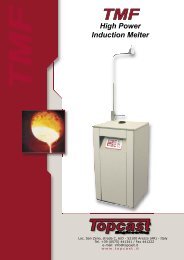w w w . t o p c a s t . i t
w w w . t o p c a s t . i t
w w w . t o p c a s t . i t
You also want an ePaper? Increase the reach of your titles
YUMPU automatically turns print PDFs into web optimized ePapers that Google loves.
w w w . t o p c a s t . i t
Model TVC12-D Modello<br />
Working capacity 3 kg Au Capacita’ di fusione<br />
Power 12 kW Potenza<br />
Vacuum pump 25 m 3 /h Pompa del vuoto<br />
Pressure range -1 / +2 bar Range di pressione<br />
Max temperature 1600 o C Temperatura massima<br />
Cycle time 5 min Tempo di ciclo<br />
User programs 100 Numero programmi<br />
Dimensions (mm) 700 x 900 x 1300 Dimensioni (mm)<br />
Weight 350 kg Peso<br />
Cooling water<br />
temperature<br />
20 - 35 o C<br />
Cooling water pressure 2 - 4 bar<br />
Temperatura acqua di<br />
raffreddamento<br />
Pressione acqua di<br />
raffreddamento<br />
Minimum water flow 6 l/min Portata minima acqua<br />
Compressed air 5 - 8 bar Aria compressa<br />
Argon 2,5 bar Argon<br />
TVC-D<br />
Vacuum furnace for dental alloys production<br />
Forno sottovuoto per la produzione di leghe dentali<br />
Il modello TVC-D e’ indicato per la produzione<br />
di leghe dentali sottoforma di semilavorati<br />
quali lastra e tondo.<br />
Il ciclo di lavoro prevede la fusione del metallo<br />
in atmosfera inerte e la successiva colata nello<br />
stampo di rame che nel frattempo e’ stato<br />
posto sotto vuoto. Alla colata segue la fase di<br />
compressione del metallo durante il periodo di<br />
solidificazione.<br />
Il sistema di riscaldamento e’ costituito da un<br />
generatore ad induzione a media frequenza<br />
che garantisce un ottimo rimescolamento nella<br />
lega da colare. La misura della temperatura<br />
e’ molto accurata ed e’ effettuata tramite<br />
termocoppia.<br />
L’ambiente di processo e’ diviso in due<br />
parti, ognuna con un controllo di vuoto e di<br />
pressione indipendente dall’altra, cosi’ da poter<br />
differenziare le pressioni tra la camera fusoria<br />
e la camera dello stampo al momento della<br />
colata, ottenendo il controllo sulla velocita’ di<br />
iniezione e sulla dimensione del grano.<br />
La parte superiore ospita un crogiolo cilindrico<br />
forato in grafite (per alcune leghe si e’ optato<br />
per l’uso di un crogiolo in materiale non<br />
grafitico) ed un sistema ad otturatore che<br />
gestisce la chiusura e l’apertura del foro.<br />
La parte inferiore ospita la lingottiera in rame<br />
che costituisce lo stampo.<br />
La tenuta tra le due camere e’ garantita da<br />
guarnizioni ceramiche resistenti ad alta<br />
temperatura.<br />
Il pannello operatore e’ semplice ed intuitivo<br />
rimandando a soli tre tasti la normale gestione<br />
del ciclo fusorio e ad un touch-screen la<br />
modifica dei programmi utente.<br />
La produttivita’ di questa macchina e’ molto<br />
alta. Si riescono a colare lastre fi leghe preziose<br />
da 3 kg in meno di 5 minuti.<br />
The vacuum casting machine type TVC-D is<br />
used to cast precious metals based alloys to<br />
produce commercial dental alloys in ingots<br />
shape.<br />
The working cycle consists in melting the alloy<br />
under protective gas by means of induction<br />
heating and then pouring the liquid metal<br />
in to a vacuumed copper mould. During the<br />
solidification phase a strong compression<br />
takes place in order to compact the metal.<br />
The furnace goes through the cycle<br />
automatically (the operator only has to load<br />
the alloy and change the ingot mould after<br />
each pouring).<br />
Main features are:<br />
- High power frequency converter features<br />
rapid melting of the alloy.<br />
- Medium frequency induction heating<br />
stirs the molten alloy and leads to high<br />
homogeneity of the alloys.<br />
- Gas washing feature to melt in protective<br />
atmosphere with minimum gas<br />
consumption.<br />
- Powerful vacuum pump (included in the<br />
machine) and an accurate sealing of the two<br />
chambers leads to absence of blow holes on<br />
the ingots obtained. Vacuum also degases<br />
the metal during the melting phase.<br />
- While the last ingot is cooling down after<br />
casting, new alloy can be loaded and melted.<br />
This leads to a working cycle very short.<br />
- Thanks to the casting from the bottom of the<br />
crucible, dirt, due to the difference in density,<br />
floats on the surface of the molten alloy and,<br />
once the pouring cycle is over, is deposited<br />
in the stem of feeding canal.<br />
- You can adjust the metal flow rate during<br />
pouring controlling the grain size in the<br />
ingot produced.<br />
- Rapid changing of the shutter, crucible and<br />
refractory, without using any glue or sealant.<br />
- 100 user-defined independent casting<br />
programs, each one storing casting<br />
temperature, vacuum/pressure values,<br />
timing of melting, casting, solidification,<br />
colling phases.<br />
- Perfect repeatibility of the process: you just<br />
need to assign a casting program for each<br />
combination of alloy.<br />
- LCD display with touch-screen to set all<br />
commands, display variables and alarms. It<br />
also helps the operator with indications on<br />
operations to follow.<br />
- Mould placement check before casting.<br />
- Advanced thermoregulation with self-tuning<br />
and exact temperature control of the alloys.<br />
You can also limit the maximum power<br />
when you work with small quantities.<br />
- Optional printer or interface to computers or<br />
networks.
Model TCE3-D TCE5-D TCE5 Modello<br />
Working capacity 80 g Au 150 g Au 400 g Au Capacita’ di fusione<br />
Power 3 kW 5 kW 8 kW Potenza<br />
Residual Vacuum - 0.1 mbar 0,1 mbar Vuoto residuo<br />
Vacuum pump - 25 m 3 /h 25 m 3 /h Pompa del vuoto<br />
Max temperature 2000 o C 2000 o C 2000 o C Temperatura massima<br />
Max speed 500 rpm 500 rpm 500 rpm Velocit’ massima<br />
Max Flask size (mm) Ø90 - H60 Ø100 - H130 Ø120 - H120 Dimensione cilindri (mm)<br />
User programs 1 100 100 Numero programmi<br />
Dimensions (mm) 600 x 600 x 950 600 x 670 x 1100 600 x 670 x 1100 Dimensioni (mm)<br />
Weight 150 kg 250 kg 250 kg Peso<br />
Cooling water<br />
temperature<br />
20 - 35 o C 20 - 35 o C 20 - 35 o C<br />
Cooling water pressure 2 - 4 bar 2 - 4 bar 2 - 4 bar<br />
TCE-D<br />
Vacuum Centrifugal Casting Machine<br />
Fonditrice Centrifuga Sottovuoto per Microfusione<br />
La macchina e’ indicata per la produzione di<br />
articoli microfusi con il metodo a cera persa.<br />
Il ciclo di lavoro prevede la fusione del metallo<br />
in atmosfera inerte oppure sotto vuoto e la<br />
successiva iniezione nello stampo refrattario<br />
per mezzo della forza centrifuga esercitata<br />
lungo l’asse dello stampo. Prima della fusione<br />
e’ possibile operare un certo numero di lavaggi<br />
con gas inerte al fine di ridurre la presenza di<br />
ossigeno residuo nella camera.<br />
Il sistema di riscaldamento e’ costituito<br />
da un generatore ad induzione a media<br />
frequenza che garantisce un rapido ed ottimo<br />
rimescolamento nella lega da colare. La misura<br />
della temperatura e’ effettuata da un pirometro<br />
ottico ad infrarossi.<br />
Alla colata segue la fase di compressione del<br />
metallo durante la solidificazione.<br />
Il braccio della centrifuga puo’ essere sia<br />
intero che spezzato. Quest’ultimo presenta il<br />
vantaggio di avere la direzione di iniezione<br />
sempre coassiale rispetto al cilindro, con<br />
conseguente omogeneo riempimento dello<br />
stesso. La rotazione del braccio e’ affidata ad<br />
un motore a basso momento di inerzia per<br />
ottenere forti accelerazioni iniziali, mentre<br />
il profilo di velocita’ e’ regolabile ottenendo<br />
cosi’ il controllo sulla rapidita’ di iniezione e<br />
sulla compressione successiva. Un sistema<br />
pneumatico effettua la salita e la discesa della<br />
bobina di riscaldamento intorno al crogioloche<br />
puo’ essere sia ceramico che di grafite.<br />
Una potente pompa del vuoto, interna alla<br />
macchina, garantisce rapidi cicli di lavoro.<br />
Il pannello operatore e’ semplice ed intuitivo,<br />
con soli tre tasti avviene la normale gestione<br />
del ciclo fusorio e con un touch-screen la<br />
modifica dei programmi utente.<br />
La fonditrice TCE puo’ fondere tutte le leghe<br />
dentali di uso comune.<br />
Temperatura acqua di<br />
raffreddamento<br />
Pressione acqua di<br />
raffreddamento<br />
Minimum water flow 6 l/min 6 l/min 6 l/min Portata minima acqua<br />
Compressed air 5 - 8 bar 5 - 8 bar 5 - 8 bar Aria compressa<br />
Argon (optional) 2,5 bar Argon (opzionale)<br />
The machine is suited to produce precise items<br />
with lost-wax investment casting technics.<br />
The casting cycle begins with alloys melting<br />
under protective gas or vacuum and continues<br />
with casting into the flask by centrifugal force.<br />
Before melting is possible to perform a number<br />
of gas washing procedures in order to reduce<br />
the oxygen content.<br />
An advanced induction heating system<br />
guarantee a fast and homogeneous mixing<br />
of the alloy before casting. After casting<br />
and during the solidificatin phase, a strong<br />
compression takes place into the mould.<br />
Temperature measurement is achieved by a<br />
precise infrared optical pyrometer.<br />
The crucible can be made of ceramic or<br />
graphite and a pneumatic lift moves up and<br />
down the coil around it during the heating<br />
time.<br />
As an option, you can have the arm of the<br />
centrifuge broken with a pivot placed away<br />
from the rotational axis. This takes the<br />
advantage to have the casting direction always<br />
in axis with the flask while rotating. The rotation<br />
of the arm is done by a motor with low mass<br />
inertia in order to obtain higher acceleration<br />
while a powerful vacuum pump guarantees<br />
fast casting cycles. The maximum speed, speed<br />
profile, casting temperature, emissivity and<br />
other secondary parameters can be set in one<br />
of the 99 user programs. The operator panel is<br />
simple and intuitive and, to launch the casting<br />
process you need only one pushbutton.<br />
To edit casting programs and monitor the<br />
process, a touch-screen with Synoptic Display<br />
is provided. The machine comes out with a<br />
number of programs already set and ready to<br />
be used for the most common alloys.<br />
The TCE machine is suitable to cast any dental<br />
alloy.



